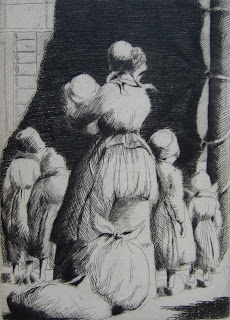Etching, 1927
Gaston Nick’s career appears to come to an end with an edition of Henriot’s Le Diable à l’hotel in 1944; the following year, his career was surveyed by Pierre Mornand in Trente Artistes du Livre. It would be easy to assume that Gaston Nick perished during the war; but in fact he simply changed his name. In 1946 he published an edition of George Sand’s La Petite Fadette, illustrated with colour etchings, under the name G. Nick Petrelli. He used the same name for a solo exhibition at Pelletan Helleu in 1947, and an exhibition at Villefranche-de-Rouergue in 1953, consisting of paintings and etchings of the village of Najac in Aveyron. The reason for this change of name is obscure, but as it is not immediately obvious that Gaston Nick and Nick Petrelli are in fact the same person, the result is that Nick seems to disappear abruptly from the record, and Petrelli to arrive from nowhere. As with Denis Volx, this switchback of nomenclature has understandably confused his posthumous reputation. I do not know when Gaston Nick died, but I assume sometime in the 1950s.
Etching, 1928
My third batch of images shows a selection of Gaston Nick's wood engravings from the 1930s, executed for various titles in the series Le livre de demain. These are competently executed, but to my mind they lack the charm of his etchings of the 1920s.
Wood engraving, 1936
Gaston Nick, Chapterhead for Les Poux de Lion
Wood engraving, 1936
Looking at Nick's etchings while writing this post, the deliberate semi-naivety of the round-faced characters kept reminding me of a work by someone else, but I couldn't remember who. Now I have found the work I was thinking of, and I do think it bears quite remarkable stylistic resemblance. It is an 1864 etching by Armand Queyroy.
Etching, 1864
Mathurin Louis Armand Queyroy was born in Vendôme (Loir-et-Cher) in 1830. Queyroy studied painting under Luminais, and etching under Maxime Lalanne. Armand Queyroy was, like Lalanne, a founder member of the Société des Aquafortistes, who published a number of his etchings. He contributed etchings to the journals L'Illustration Nouvelle, Gazette des Beaux-Arts, and L'Artiste. He lived in Moulins in the Auvergne, and in the 1860s published several albums of etchings of subjects in the Auvergne, including an album of 21 plates, printed by Delâtre, of Le vieux Moulins. His similar album Le vieux Blois of 1864 earned him a letter of praise from Victor Hugo, and Queyroy was quick to reissue it with a facsimile of Hugo's letter. Armand Queyroy's etchings appeared between 1862 and 1886. He died in 1893.





























6 comments:
Interesting story and some great images. The 1927 Canalside composition very strong, my favorite, like his observations of children and market day peasantry. Very worthwhile, like the Provence woodcuts.
Thanks for introducing him.
Yes, I've been admiring the Canalside one, too. He liked drawing people from behind, didn't he? I like the château from Egalité as well - a resplendent building with its pointed roofs, as if still shining from its restoration by Viollet le Duc in the previous century.
His images of people together are so convincing, so finely observed. If we are voting for favorites, I like the children in front of the shop window. Nick's drawing skills are very good, I think, because he doesn't use that much dark/light contrast in his etchings. he doesn't make things easy for himself.
Gerrie - I too like the canalside image.
Philip - You're right about drawing people from behind - he somehow seems to get more character and definition from the rear than face-on. Of the woodcuts I particularly like the chapter head for Egalité, for its cinematic quality.
Jane - You're right, he's good at groups of people interrelating. Also that the lack of contrast in the etchings does place extra emphasis on his draughtsmanship.
Post a Comment